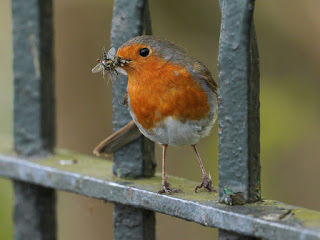There was another Reed Warbler singing at the east end of the Serpentine.
A Long-Tailed Tit in the Rose Garden brought insects to the nest in the gorse bush. I can't hear any sound of nestlings and it may just be feeding its sitting mate, but it's about time the eggs hatched.
A Robin beside the Long Water collected insects for its nestlings.
A female Greenfinch perched on a pile of brushwood.
A female Blackcap bounced around in a hawthorn tree, scolding some unseen predator.
A male Rose-Ringed Parakeet ate dandelion leaves, one of their favourite foods.
The female Little Owl was in the alder tree again.
The focus of the disturbance among these Grey Herons is the young bird in the foreground, which is unusually aggressive and frightens its seniors.
An Egyptian Goose on the Serpentine has nine brand new goslings.
The lone gosling on the Long Water is still with us.
The Mute Swans nesting on the little island in the Long Water have now completely dismantled the Coots' nest to use the materials in their own nest. The Coots have nowhere to look after their newly hatched chicks.
One of them chased off a hungry Lesser Black-Backed Gull and went to feed the chicks on a convenient ornamental rock. They may be able to keep their chicks safe on the reeds while building a new nest, something Coots can do in a day.
The swan nesting east of the Lido kept a foot on her egg to avoid warming it. The eggs will stay viable while she lays more, and only start developing when she warms them all by sitting in earnest. That is, if she gets as far as that in this exposed place.
A close-up of the egg.
A pair of Coots ate each other's parasites, the nearest that Coots get to courtship.
But Gadwalls seem to be genuinely fond of each other.
Buff-Tailed Bumblebees may be the easiest of all insects to photograph, but that's no reason not to take pictures of these charming flying teddy bears.












There can never be too many pictures of bumblebees. They make life better.
ReplyDeletePoor evicted Coots. The poor chicks look pitiably weak and exposed. I hope their building abilities won't desert them when they need them most.
Would the Long Tailed Tits' chicks be audible? I find it hard to hear the adults from a distance.
I'm wondering now whether Long-Tailed Tit chicks are silent, at least when they're very young. It would be safer for them. This is new territory because it's the first time I've been able to study a nest close up.
DeleteThough I often curse them your photo of the male Ring-necked Parakeet shows how exquisite they can be.
ReplyDeleteGood your Reed Warblers have returned. Haven't connected with one yet. Plenty of Whiethroats on my main patch now & have been pleased to hear 3 singing Willow Warblers at different local sites over the past week- the best showing for a few years. This morning was so excited to find my first local male Ring Ouzel. Also 3 Wheatears over 2 sites but get these every spring/autumn passage.
No Willow Warblers here yet. We usually get a few. But never any Ring Ouzels. A report a few years ago turned out to be a Blackbird with a white patch.
Delete